Evaluating Strategic Leadership and its Influence on Ooredoo Maldives
VerifiedAdded on 2022/09/09
|24
|6506
|14
Report
AI Summary
This report provides an in-depth analysis of strategic leadership, focusing on its application and impact within Ooredoo Maldives, a prominent telecom company. The paper begins by defining leadership and its importance, exploring various leadership approaches such as trait, functional, situational, relational, and transformational. It then delves into the role of leadership in strategic management, comparing the relationships between work group and team leaders. The report further distinguishes between the influence of leadership on groups and teams, as well as formal and informal groups. Key characteristics of effective work groups and teams are evaluated. The study assesses organizational effectiveness and performance, exploring leadership development requirements and criteria for strategic effectiveness. Additionally, it examines the exercise of leadership power, the importance of ethics, values, and corporate social responsibility, and evaluates leadership and sustainability concepts. The report provides valuable insights into how strategic leadership can enhance organizational growth and success in a competitive business environment.
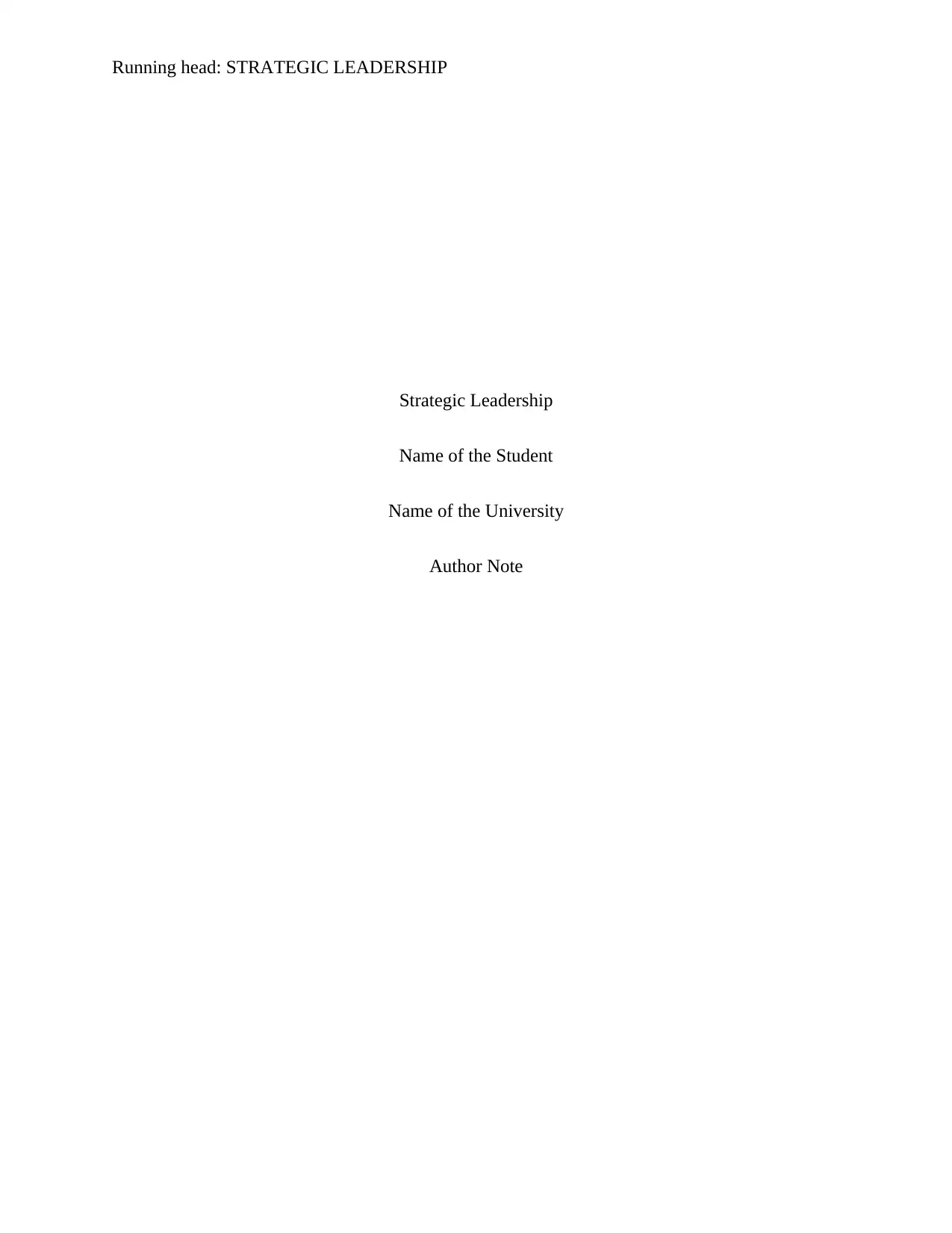
Running head: STRATEGIC LEADERSHIP
Strategic Leadership
Name of the Student
Name of the University
Author Note
Strategic Leadership
Name of the Student
Name of the University
Author Note
Paraphrase This Document
Need a fresh take? Get an instant paraphrase of this document with our AI Paraphraser
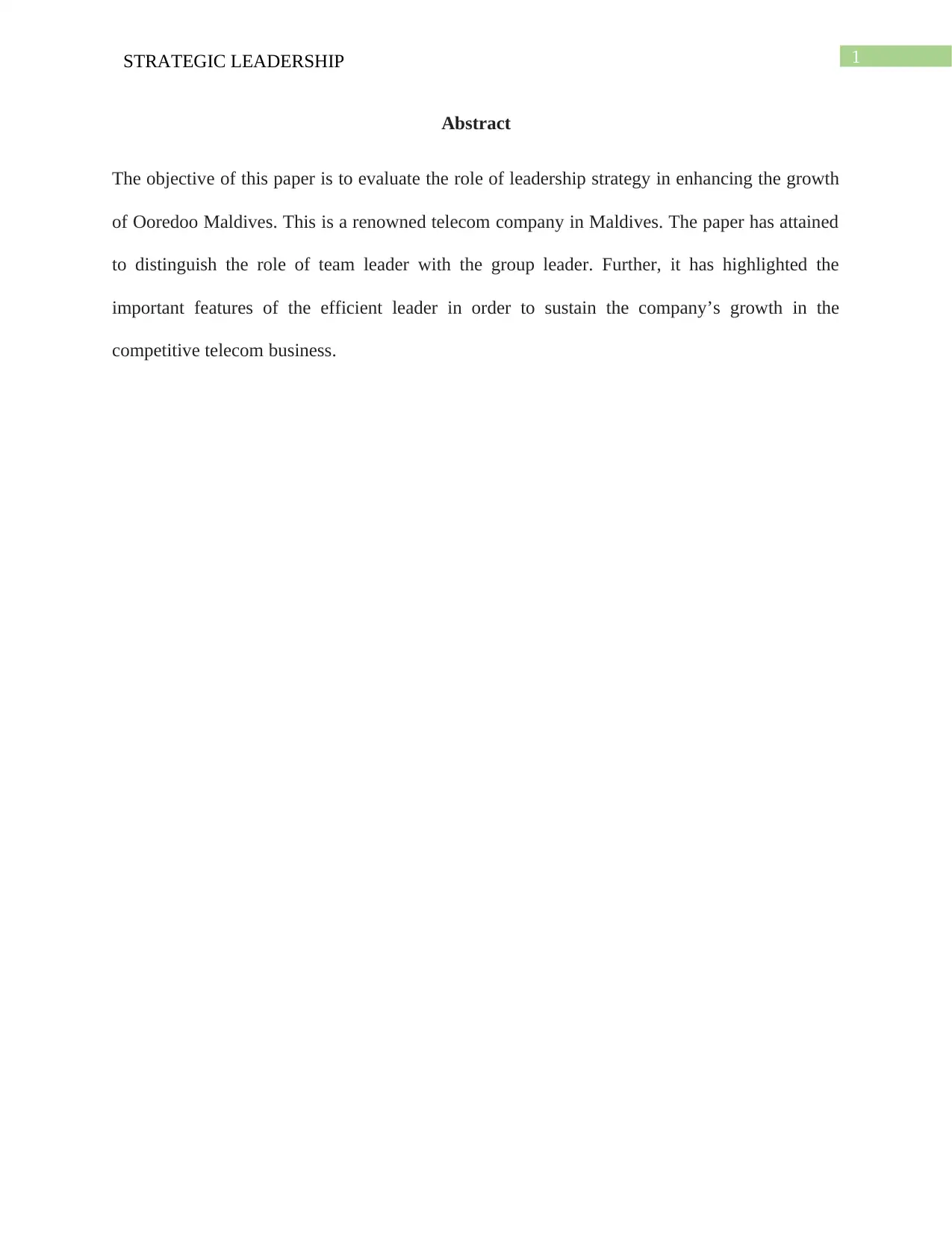
1STRATEGIC LEADERSHIP
Abstract
The objective of this paper is to evaluate the role of leadership strategy in enhancing the growth
of Ooredoo Maldives. This is a renowned telecom company in Maldives. The paper has attained
to distinguish the role of team leader with the group leader. Further, it has highlighted the
important features of the efficient leader in order to sustain the company’s growth in the
competitive telecom business.
Abstract
The objective of this paper is to evaluate the role of leadership strategy in enhancing the growth
of Ooredoo Maldives. This is a renowned telecom company in Maldives. The paper has attained
to distinguish the role of team leader with the group leader. Further, it has highlighted the
important features of the efficient leader in order to sustain the company’s growth in the
competitive telecom business.
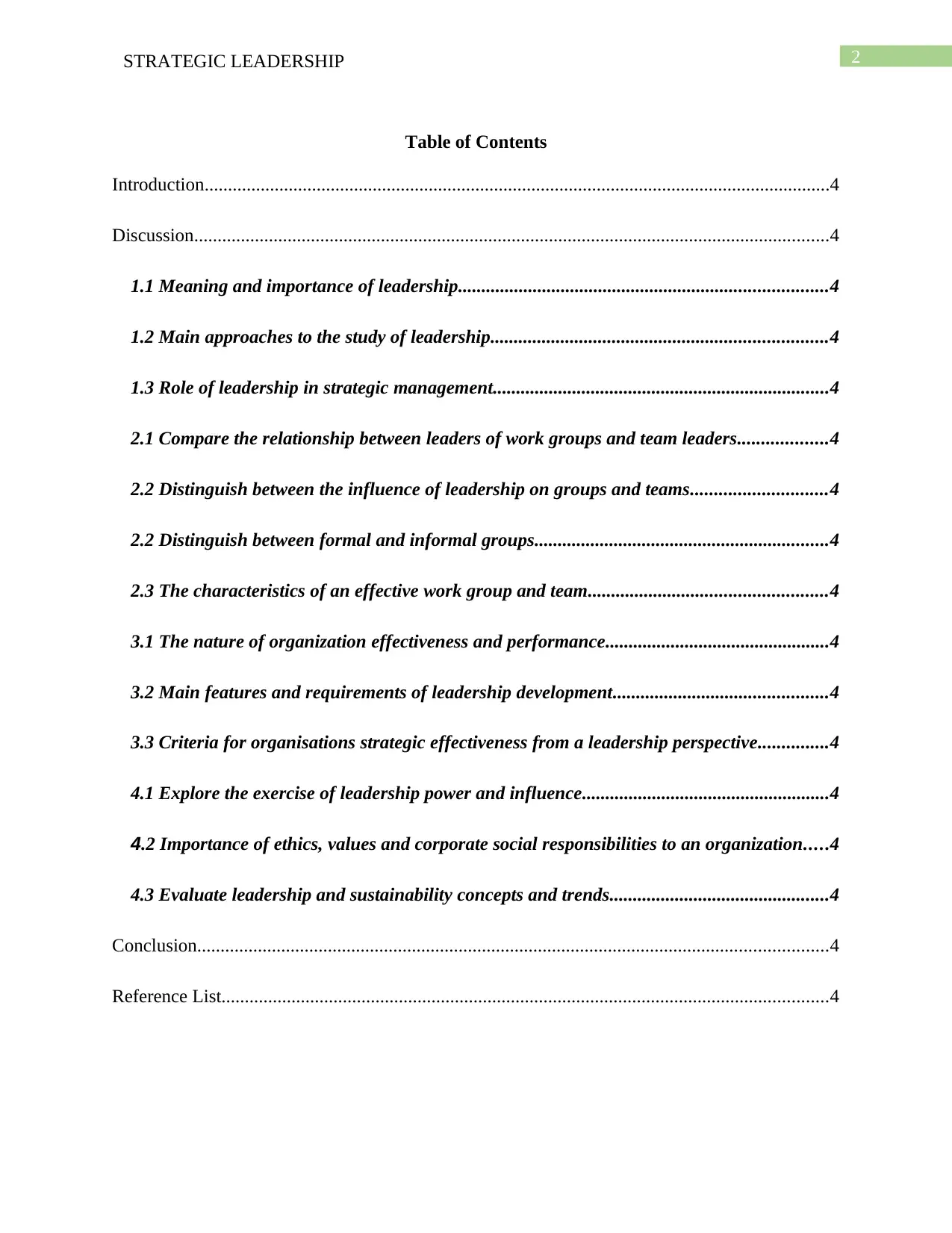
2STRATEGIC LEADERSHIP
Table of Contents
Introduction......................................................................................................................................4
Discussion........................................................................................................................................4
1.1 Meaning and importance of leadership...............................................................................4
1.2 Main approaches to the study of leadership........................................................................4
1.3 Role of leadership in strategic management........................................................................4
2.1 Compare the relationship between leaders of work groups and team leaders...................4
2.2 Distinguish between the influence of leadership on groups and teams.............................4
2.2 Distinguish between formal and informal groups...............................................................4
2.3 The characteristics of an effective work group and team...................................................4
3.1 The nature of organization effectiveness and performance................................................4
3.2 Main features and requirements of leadership development..............................................4
3.3 Criteria for organisations strategic effectiveness from a leadership perspective...............4
4.1 Explore the exercise of leadership power and influence.....................................................4
4.2 Importance of ethics, values and corporate social responsibilities to an organization.....4
4.3 Evaluate leadership and sustainability concepts and trends...............................................4
Conclusion.......................................................................................................................................4
Reference List..................................................................................................................................4
Table of Contents
Introduction......................................................................................................................................4
Discussion........................................................................................................................................4
1.1 Meaning and importance of leadership...............................................................................4
1.2 Main approaches to the study of leadership........................................................................4
1.3 Role of leadership in strategic management........................................................................4
2.1 Compare the relationship between leaders of work groups and team leaders...................4
2.2 Distinguish between the influence of leadership on groups and teams.............................4
2.2 Distinguish between formal and informal groups...............................................................4
2.3 The characteristics of an effective work group and team...................................................4
3.1 The nature of organization effectiveness and performance................................................4
3.2 Main features and requirements of leadership development..............................................4
3.3 Criteria for organisations strategic effectiveness from a leadership perspective...............4
4.1 Explore the exercise of leadership power and influence.....................................................4
4.2 Importance of ethics, values and corporate social responsibilities to an organization.....4
4.3 Evaluate leadership and sustainability concepts and trends...............................................4
Conclusion.......................................................................................................................................4
Reference List..................................................................................................................................4
⊘ This is a preview!⊘
Do you want full access?
Subscribe today to unlock all pages.

Trusted by 1+ million students worldwide
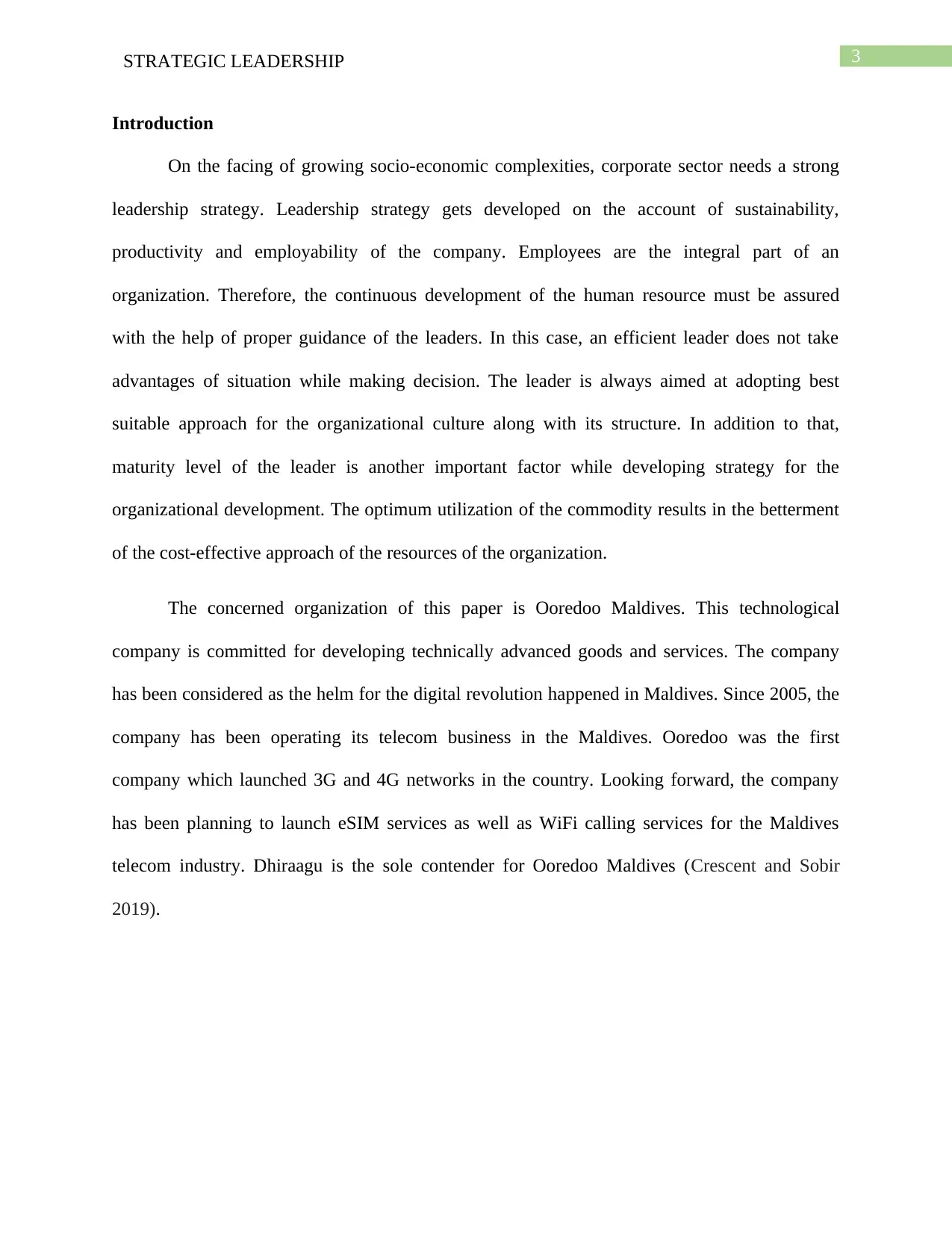
3STRATEGIC LEADERSHIP
Introduction
On the facing of growing socio-economic complexities, corporate sector needs a strong
leadership strategy. Leadership strategy gets developed on the account of sustainability,
productivity and employability of the company. Employees are the integral part of an
organization. Therefore, the continuous development of the human resource must be assured
with the help of proper guidance of the leaders. In this case, an efficient leader does not take
advantages of situation while making decision. The leader is always aimed at adopting best
suitable approach for the organizational culture along with its structure. In addition to that,
maturity level of the leader is another important factor while developing strategy for the
organizational development. The optimum utilization of the commodity results in the betterment
of the cost-effective approach of the resources of the organization.
The concerned organization of this paper is Ooredoo Maldives. This technological
company is committed for developing technically advanced goods and services. The company
has been considered as the helm for the digital revolution happened in Maldives. Since 2005, the
company has been operating its telecom business in the Maldives. Ooredoo was the first
company which launched 3G and 4G networks in the country. Looking forward, the company
has been planning to launch eSIM services as well as WiFi calling services for the Maldives
telecom industry. Dhiraagu is the sole contender for Ooredoo Maldives (Crescent and Sobir
2019).
Introduction
On the facing of growing socio-economic complexities, corporate sector needs a strong
leadership strategy. Leadership strategy gets developed on the account of sustainability,
productivity and employability of the company. Employees are the integral part of an
organization. Therefore, the continuous development of the human resource must be assured
with the help of proper guidance of the leaders. In this case, an efficient leader does not take
advantages of situation while making decision. The leader is always aimed at adopting best
suitable approach for the organizational culture along with its structure. In addition to that,
maturity level of the leader is another important factor while developing strategy for the
organizational development. The optimum utilization of the commodity results in the betterment
of the cost-effective approach of the resources of the organization.
The concerned organization of this paper is Ooredoo Maldives. This technological
company is committed for developing technically advanced goods and services. The company
has been considered as the helm for the digital revolution happened in Maldives. Since 2005, the
company has been operating its telecom business in the Maldives. Ooredoo was the first
company which launched 3G and 4G networks in the country. Looking forward, the company
has been planning to launch eSIM services as well as WiFi calling services for the Maldives
telecom industry. Dhiraagu is the sole contender for Ooredoo Maldives (Crescent and Sobir
2019).
Paraphrase This Document
Need a fresh take? Get an instant paraphrase of this document with our AI Paraphraser
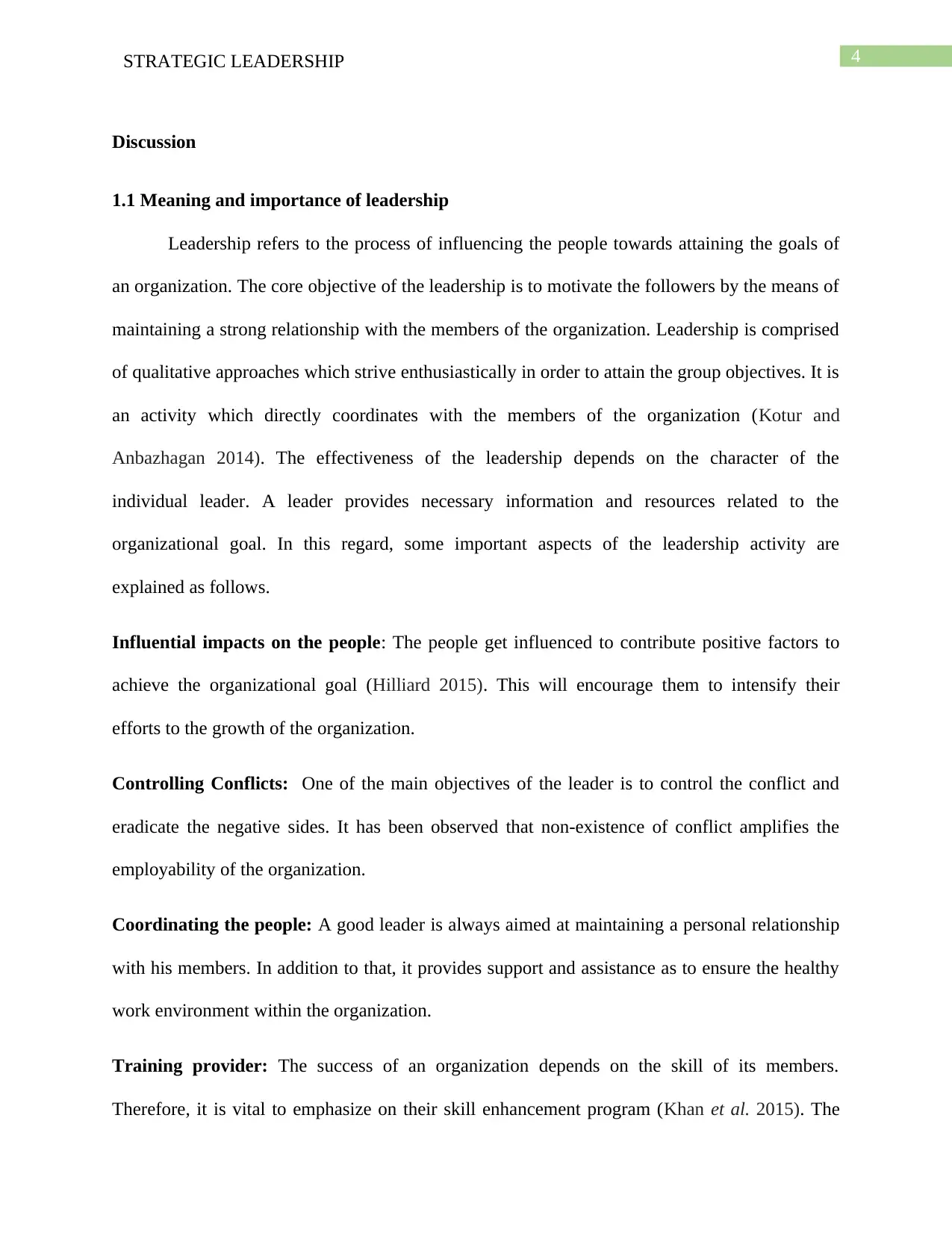
4STRATEGIC LEADERSHIP
Discussion
1.1 Meaning and importance of leadership
Leadership refers to the process of influencing the people towards attaining the goals of
an organization. The core objective of the leadership is to motivate the followers by the means of
maintaining a strong relationship with the members of the organization. Leadership is comprised
of qualitative approaches which strive enthusiastically in order to attain the group objectives. It is
an activity which directly coordinates with the members of the organization (Kotur and
Anbazhagan 2014). The effectiveness of the leadership depends on the character of the
individual leader. A leader provides necessary information and resources related to the
organizational goal. In this regard, some important aspects of the leadership activity are
explained as follows.
Influential impacts on the people: The people get influenced to contribute positive factors to
achieve the organizational goal (Hilliard 2015). This will encourage them to intensify their
efforts to the growth of the organization.
Controlling Conflicts: One of the main objectives of the leader is to control the conflict and
eradicate the negative sides. It has been observed that non-existence of conflict amplifies the
employability of the organization.
Coordinating the people: A good leader is always aimed at maintaining a personal relationship
with his members. In addition to that, it provides support and assistance as to ensure the healthy
work environment within the organization.
Training provider: The success of an organization depends on the skill of its members.
Therefore, it is vital to emphasize on their skill enhancement program (Khan et al. 2015). The
Discussion
1.1 Meaning and importance of leadership
Leadership refers to the process of influencing the people towards attaining the goals of
an organization. The core objective of the leadership is to motivate the followers by the means of
maintaining a strong relationship with the members of the organization. Leadership is comprised
of qualitative approaches which strive enthusiastically in order to attain the group objectives. It is
an activity which directly coordinates with the members of the organization (Kotur and
Anbazhagan 2014). The effectiveness of the leadership depends on the character of the
individual leader. A leader provides necessary information and resources related to the
organizational goal. In this regard, some important aspects of the leadership activity are
explained as follows.
Influential impacts on the people: The people get influenced to contribute positive factors to
achieve the organizational goal (Hilliard 2015). This will encourage them to intensify their
efforts to the growth of the organization.
Controlling Conflicts: One of the main objectives of the leader is to control the conflict and
eradicate the negative sides. It has been observed that non-existence of conflict amplifies the
employability of the organization.
Coordinating the people: A good leader is always aimed at maintaining a personal relationship
with his members. In addition to that, it provides support and assistance as to ensure the healthy
work environment within the organization.
Training provider: The success of an organization depends on the skill of its members.
Therefore, it is vital to emphasize on their skill enhancement program (Khan et al. 2015). The
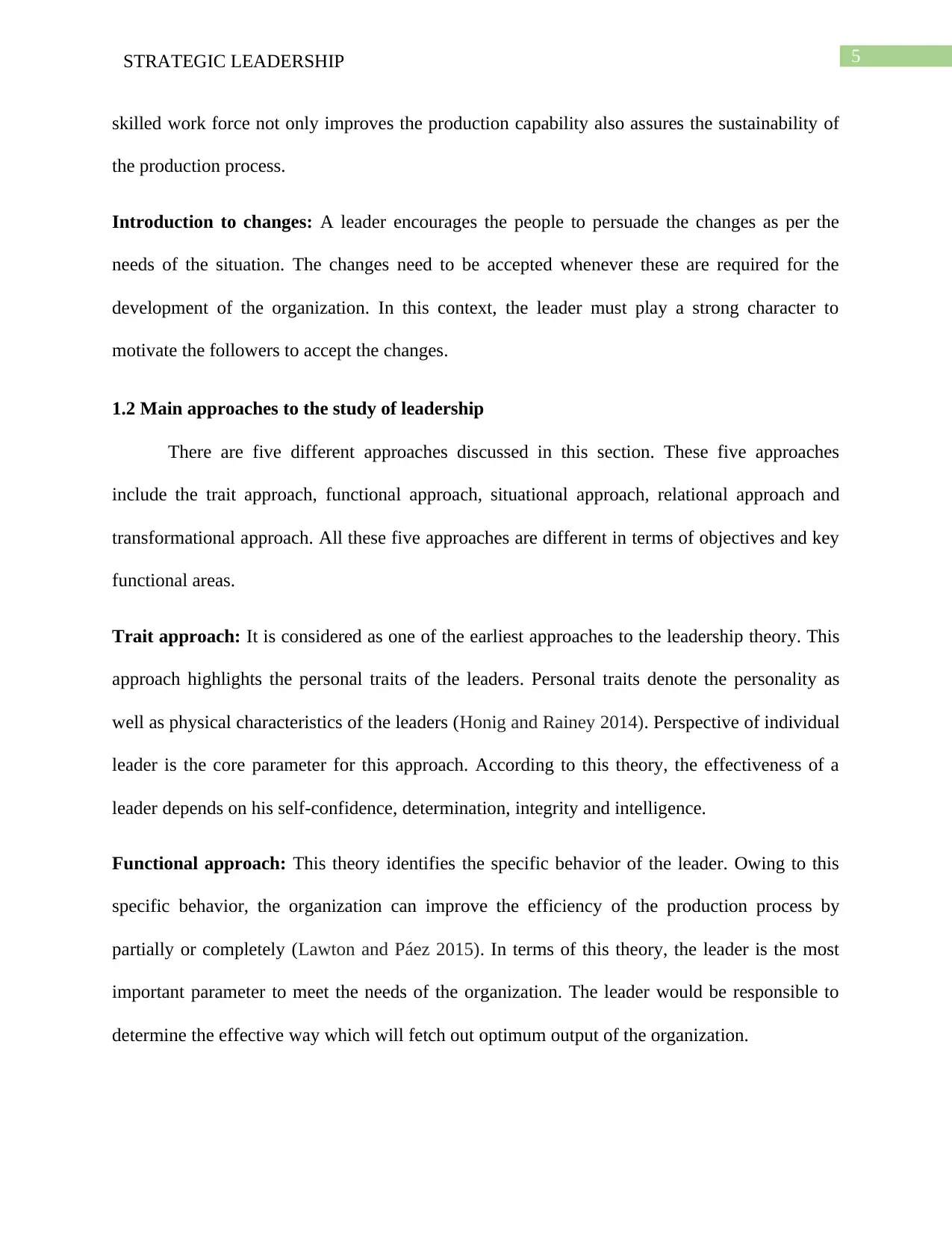
5STRATEGIC LEADERSHIP
skilled work force not only improves the production capability also assures the sustainability of
the production process.
Introduction to changes: A leader encourages the people to persuade the changes as per the
needs of the situation. The changes need to be accepted whenever these are required for the
development of the organization. In this context, the leader must play a strong character to
motivate the followers to accept the changes.
1.2 Main approaches to the study of leadership
There are five different approaches discussed in this section. These five approaches
include the trait approach, functional approach, situational approach, relational approach and
transformational approach. All these five approaches are different in terms of objectives and key
functional areas.
Trait approach: It is considered as one of the earliest approaches to the leadership theory. This
approach highlights the personal traits of the leaders. Personal traits denote the personality as
well as physical characteristics of the leaders (Honig and Rainey 2014). Perspective of individual
leader is the core parameter for this approach. According to this theory, the effectiveness of a
leader depends on his self-confidence, determination, integrity and intelligence.
Functional approach: This theory identifies the specific behavior of the leader. Owing to this
specific behavior, the organization can improve the efficiency of the production process by
partially or completely (Lawton and Páez 2015). In terms of this theory, the leader is the most
important parameter to meet the needs of the organization. The leader would be responsible to
determine the effective way which will fetch out optimum output of the organization.
skilled work force not only improves the production capability also assures the sustainability of
the production process.
Introduction to changes: A leader encourages the people to persuade the changes as per the
needs of the situation. The changes need to be accepted whenever these are required for the
development of the organization. In this context, the leader must play a strong character to
motivate the followers to accept the changes.
1.2 Main approaches to the study of leadership
There are five different approaches discussed in this section. These five approaches
include the trait approach, functional approach, situational approach, relational approach and
transformational approach. All these five approaches are different in terms of objectives and key
functional areas.
Trait approach: It is considered as one of the earliest approaches to the leadership theory. This
approach highlights the personal traits of the leaders. Personal traits denote the personality as
well as physical characteristics of the leaders (Honig and Rainey 2014). Perspective of individual
leader is the core parameter for this approach. According to this theory, the effectiveness of a
leader depends on his self-confidence, determination, integrity and intelligence.
Functional approach: This theory identifies the specific behavior of the leader. Owing to this
specific behavior, the organization can improve the efficiency of the production process by
partially or completely (Lawton and Páez 2015). In terms of this theory, the leader is the most
important parameter to meet the needs of the organization. The leader would be responsible to
determine the effective way which will fetch out optimum output of the organization.
⊘ This is a preview!⊘
Do you want full access?
Subscribe today to unlock all pages.

Trusted by 1+ million students worldwide
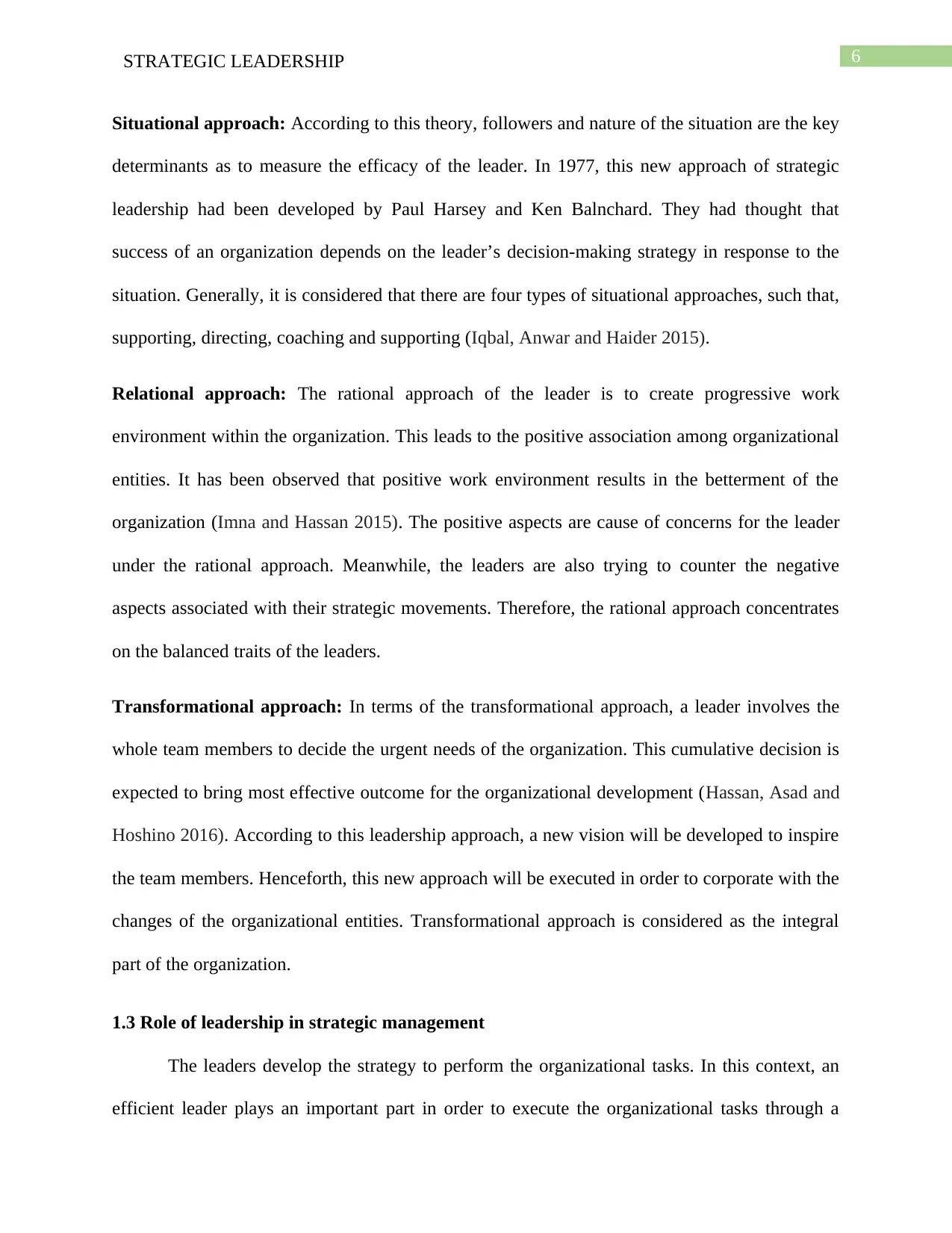
6STRATEGIC LEADERSHIP
Situational approach: According to this theory, followers and nature of the situation are the key
determinants as to measure the efficacy of the leader. In 1977, this new approach of strategic
leadership had been developed by Paul Harsey and Ken Balnchard. They had thought that
success of an organization depends on the leader’s decision-making strategy in response to the
situation. Generally, it is considered that there are four types of situational approaches, such that,
supporting, directing, coaching and supporting (Iqbal, Anwar and Haider 2015).
Relational approach: The rational approach of the leader is to create progressive work
environment within the organization. This leads to the positive association among organizational
entities. It has been observed that positive work environment results in the betterment of the
organization (Imna and Hassan 2015). The positive aspects are cause of concerns for the leader
under the rational approach. Meanwhile, the leaders are also trying to counter the negative
aspects associated with their strategic movements. Therefore, the rational approach concentrates
on the balanced traits of the leaders.
Transformational approach: In terms of the transformational approach, a leader involves the
whole team members to decide the urgent needs of the organization. This cumulative decision is
expected to bring most effective outcome for the organizational development (Hassan, Asad and
Hoshino 2016). According to this leadership approach, a new vision will be developed to inspire
the team members. Henceforth, this new approach will be executed in order to corporate with the
changes of the organizational entities. Transformational approach is considered as the integral
part of the organization.
1.3 Role of leadership in strategic management
The leaders develop the strategy to perform the organizational tasks. In this context, an
efficient leader plays an important part in order to execute the organizational tasks through a
Situational approach: According to this theory, followers and nature of the situation are the key
determinants as to measure the efficacy of the leader. In 1977, this new approach of strategic
leadership had been developed by Paul Harsey and Ken Balnchard. They had thought that
success of an organization depends on the leader’s decision-making strategy in response to the
situation. Generally, it is considered that there are four types of situational approaches, such that,
supporting, directing, coaching and supporting (Iqbal, Anwar and Haider 2015).
Relational approach: The rational approach of the leader is to create progressive work
environment within the organization. This leads to the positive association among organizational
entities. It has been observed that positive work environment results in the betterment of the
organization (Imna and Hassan 2015). The positive aspects are cause of concerns for the leader
under the rational approach. Meanwhile, the leaders are also trying to counter the negative
aspects associated with their strategic movements. Therefore, the rational approach concentrates
on the balanced traits of the leaders.
Transformational approach: In terms of the transformational approach, a leader involves the
whole team members to decide the urgent needs of the organization. This cumulative decision is
expected to bring most effective outcome for the organizational development (Hassan, Asad and
Hoshino 2016). According to this leadership approach, a new vision will be developed to inspire
the team members. Henceforth, this new approach will be executed in order to corporate with the
changes of the organizational entities. Transformational approach is considered as the integral
part of the organization.
1.3 Role of leadership in strategic management
The leaders develop the strategy to perform the organizational tasks. In this context, an
efficient leader plays an important part in order to execute the organizational tasks through a
Paraphrase This Document
Need a fresh take? Get an instant paraphrase of this document with our AI Paraphraser
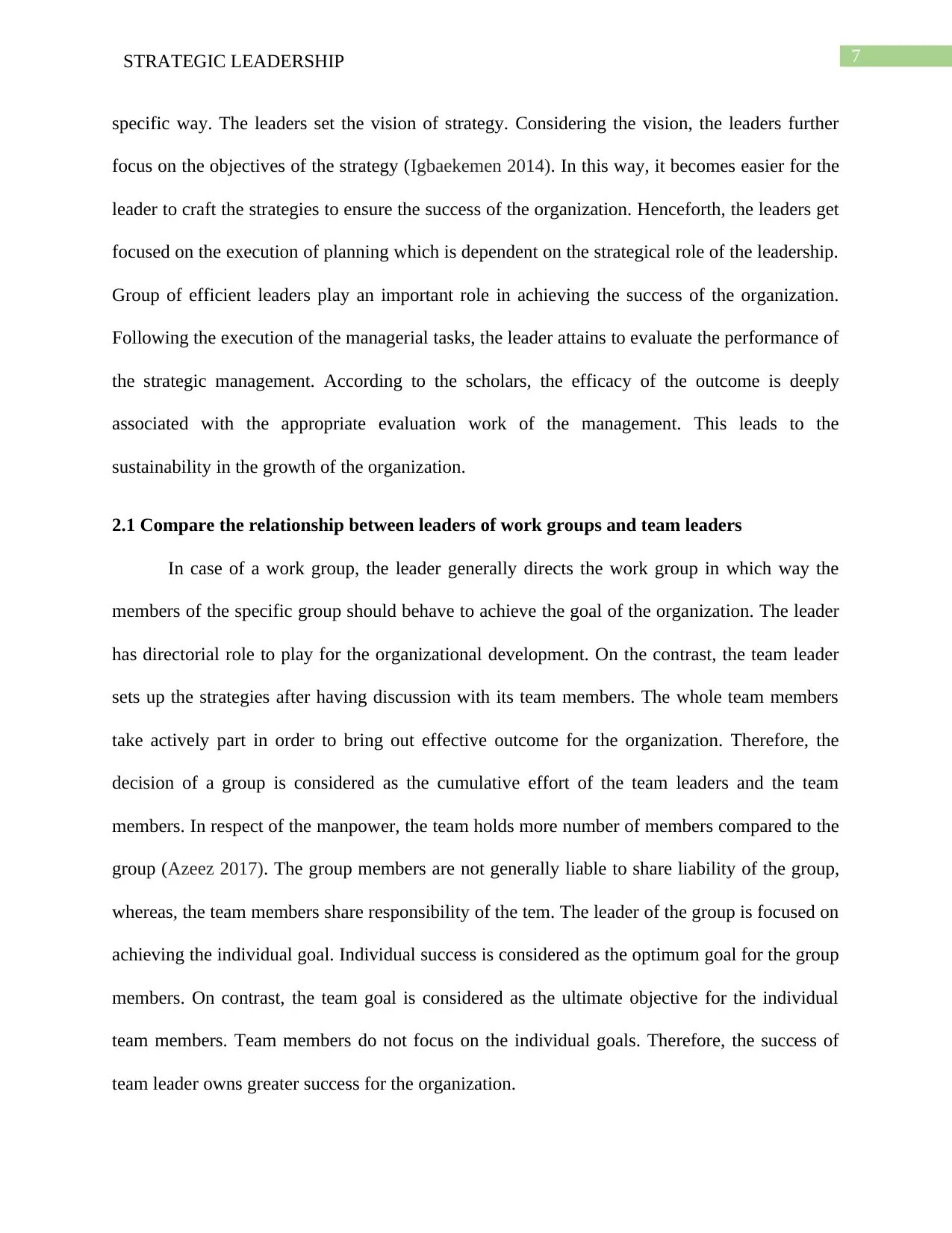
7STRATEGIC LEADERSHIP
specific way. The leaders set the vision of strategy. Considering the vision, the leaders further
focus on the objectives of the strategy (Igbaekemen 2014). In this way, it becomes easier for the
leader to craft the strategies to ensure the success of the organization. Henceforth, the leaders get
focused on the execution of planning which is dependent on the strategical role of the leadership.
Group of efficient leaders play an important role in achieving the success of the organization.
Following the execution of the managerial tasks, the leader attains to evaluate the performance of
the strategic management. According to the scholars, the efficacy of the outcome is deeply
associated with the appropriate evaluation work of the management. This leads to the
sustainability in the growth of the organization.
2.1 Compare the relationship between leaders of work groups and team leaders
In case of a work group, the leader generally directs the work group in which way the
members of the specific group should behave to achieve the goal of the organization. The leader
has directorial role to play for the organizational development. On the contrast, the team leader
sets up the strategies after having discussion with its team members. The whole team members
take actively part in order to bring out effective outcome for the organization. Therefore, the
decision of a group is considered as the cumulative effort of the team leaders and the team
members. In respect of the manpower, the team holds more number of members compared to the
group (Azeez 2017). The group members are not generally liable to share liability of the group,
whereas, the team members share responsibility of the tem. The leader of the group is focused on
achieving the individual goal. Individual success is considered as the optimum goal for the group
members. On contrast, the team goal is considered as the ultimate objective for the individual
team members. Team members do not focus on the individual goals. Therefore, the success of
team leader owns greater success for the organization.
specific way. The leaders set the vision of strategy. Considering the vision, the leaders further
focus on the objectives of the strategy (Igbaekemen 2014). In this way, it becomes easier for the
leader to craft the strategies to ensure the success of the organization. Henceforth, the leaders get
focused on the execution of planning which is dependent on the strategical role of the leadership.
Group of efficient leaders play an important role in achieving the success of the organization.
Following the execution of the managerial tasks, the leader attains to evaluate the performance of
the strategic management. According to the scholars, the efficacy of the outcome is deeply
associated with the appropriate evaluation work of the management. This leads to the
sustainability in the growth of the organization.
2.1 Compare the relationship between leaders of work groups and team leaders
In case of a work group, the leader generally directs the work group in which way the
members of the specific group should behave to achieve the goal of the organization. The leader
has directorial role to play for the organizational development. On the contrast, the team leader
sets up the strategies after having discussion with its team members. The whole team members
take actively part in order to bring out effective outcome for the organization. Therefore, the
decision of a group is considered as the cumulative effort of the team leaders and the team
members. In respect of the manpower, the team holds more number of members compared to the
group (Azeez 2017). The group members are not generally liable to share liability of the group,
whereas, the team members share responsibility of the tem. The leader of the group is focused on
achieving the individual goal. Individual success is considered as the optimum goal for the group
members. On contrast, the team goal is considered as the ultimate objective for the individual
team members. Team members do not focus on the individual goals. Therefore, the success of
team leader owns greater success for the organization.
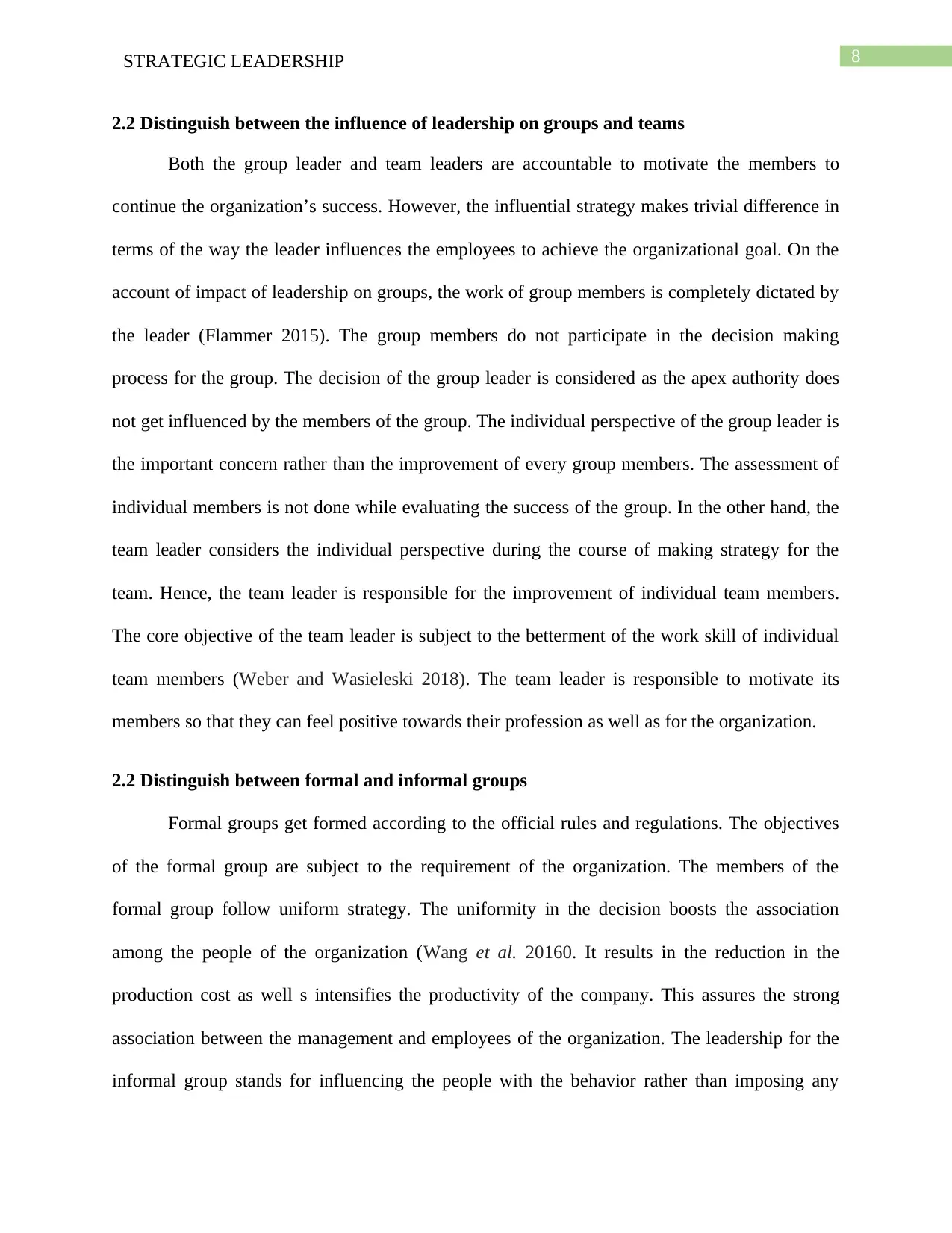
8STRATEGIC LEADERSHIP
2.2 Distinguish between the influence of leadership on groups and teams
Both the group leader and team leaders are accountable to motivate the members to
continue the organization’s success. However, the influential strategy makes trivial difference in
terms of the way the leader influences the employees to achieve the organizational goal. On the
account of impact of leadership on groups, the work of group members is completely dictated by
the leader (Flammer 2015). The group members do not participate in the decision making
process for the group. The decision of the group leader is considered as the apex authority does
not get influenced by the members of the group. The individual perspective of the group leader is
the important concern rather than the improvement of every group members. The assessment of
individual members is not done while evaluating the success of the group. In the other hand, the
team leader considers the individual perspective during the course of making strategy for the
team. Hence, the team leader is responsible for the improvement of individual team members.
The core objective of the team leader is subject to the betterment of the work skill of individual
team members (Weber and Wasieleski 2018). The team leader is responsible to motivate its
members so that they can feel positive towards their profession as well as for the organization.
2.2 Distinguish between formal and informal groups
Formal groups get formed according to the official rules and regulations. The objectives
of the formal group are subject to the requirement of the organization. The members of the
formal group follow uniform strategy. The uniformity in the decision boosts the association
among the people of the organization (Wang et al. 20160. It results in the reduction in the
production cost as well s intensifies the productivity of the company. This assures the strong
association between the management and employees of the organization. The leadership for the
informal group stands for influencing the people with the behavior rather than imposing any
2.2 Distinguish between the influence of leadership on groups and teams
Both the group leader and team leaders are accountable to motivate the members to
continue the organization’s success. However, the influential strategy makes trivial difference in
terms of the way the leader influences the employees to achieve the organizational goal. On the
account of impact of leadership on groups, the work of group members is completely dictated by
the leader (Flammer 2015). The group members do not participate in the decision making
process for the group. The decision of the group leader is considered as the apex authority does
not get influenced by the members of the group. The individual perspective of the group leader is
the important concern rather than the improvement of every group members. The assessment of
individual members is not done while evaluating the success of the group. In the other hand, the
team leader considers the individual perspective during the course of making strategy for the
team. Hence, the team leader is responsible for the improvement of individual team members.
The core objective of the team leader is subject to the betterment of the work skill of individual
team members (Weber and Wasieleski 2018). The team leader is responsible to motivate its
members so that they can feel positive towards their profession as well as for the organization.
2.2 Distinguish between formal and informal groups
Formal groups get formed according to the official rules and regulations. The objectives
of the formal group are subject to the requirement of the organization. The members of the
formal group follow uniform strategy. The uniformity in the decision boosts the association
among the people of the organization (Wang et al. 20160. It results in the reduction in the
production cost as well s intensifies the productivity of the company. This assures the strong
association between the management and employees of the organization. The leadership for the
informal group stands for influencing the people with the behavior rather than imposing any
⊘ This is a preview!⊘
Do you want full access?
Subscribe today to unlock all pages.

Trusted by 1+ million students worldwide
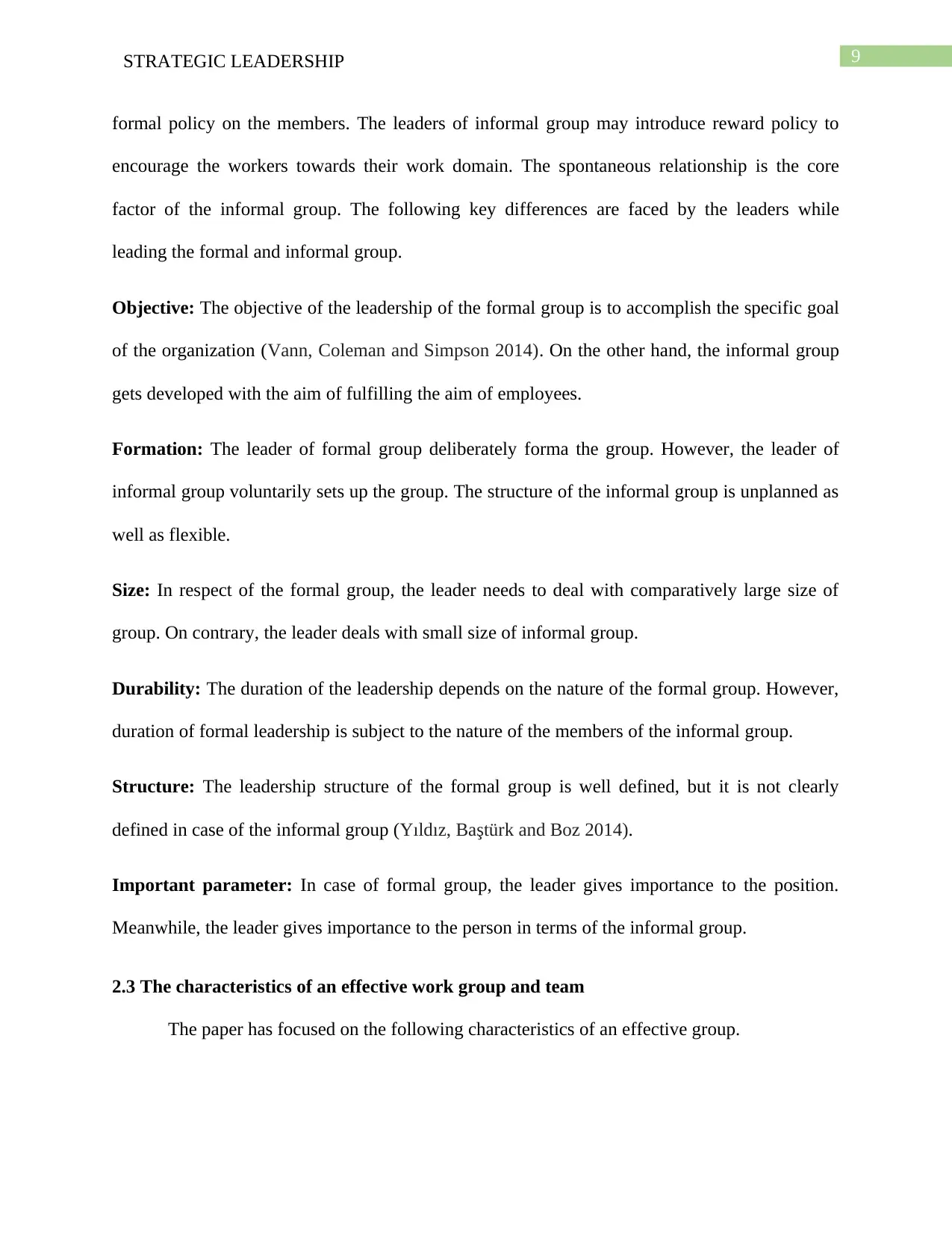
9STRATEGIC LEADERSHIP
formal policy on the members. The leaders of informal group may introduce reward policy to
encourage the workers towards their work domain. The spontaneous relationship is the core
factor of the informal group. The following key differences are faced by the leaders while
leading the formal and informal group.
Objective: The objective of the leadership of the formal group is to accomplish the specific goal
of the organization (Vann, Coleman and Simpson 2014). On the other hand, the informal group
gets developed with the aim of fulfilling the aim of employees.
Formation: The leader of formal group deliberately forma the group. However, the leader of
informal group voluntarily sets up the group. The structure of the informal group is unplanned as
well as flexible.
Size: In respect of the formal group, the leader needs to deal with comparatively large size of
group. On contrary, the leader deals with small size of informal group.
Durability: The duration of the leadership depends on the nature of the formal group. However,
duration of formal leadership is subject to the nature of the members of the informal group.
Structure: The leadership structure of the formal group is well defined, but it is not clearly
defined in case of the informal group (Yıldız, Baştürk and Boz 2014).
Important parameter: In case of formal group, the leader gives importance to the position.
Meanwhile, the leader gives importance to the person in terms of the informal group.
2.3 The characteristics of an effective work group and team
The paper has focused on the following characteristics of an effective group.
formal policy on the members. The leaders of informal group may introduce reward policy to
encourage the workers towards their work domain. The spontaneous relationship is the core
factor of the informal group. The following key differences are faced by the leaders while
leading the formal and informal group.
Objective: The objective of the leadership of the formal group is to accomplish the specific goal
of the organization (Vann, Coleman and Simpson 2014). On the other hand, the informal group
gets developed with the aim of fulfilling the aim of employees.
Formation: The leader of formal group deliberately forma the group. However, the leader of
informal group voluntarily sets up the group. The structure of the informal group is unplanned as
well as flexible.
Size: In respect of the formal group, the leader needs to deal with comparatively large size of
group. On contrary, the leader deals with small size of informal group.
Durability: The duration of the leadership depends on the nature of the formal group. However,
duration of formal leadership is subject to the nature of the members of the informal group.
Structure: The leadership structure of the formal group is well defined, but it is not clearly
defined in case of the informal group (Yıldız, Baştürk and Boz 2014).
Important parameter: In case of formal group, the leader gives importance to the position.
Meanwhile, the leader gives importance to the person in terms of the informal group.
2.3 The characteristics of an effective work group and team
The paper has focused on the following characteristics of an effective group.
Paraphrase This Document
Need a fresh take? Get an instant paraphrase of this document with our AI Paraphraser
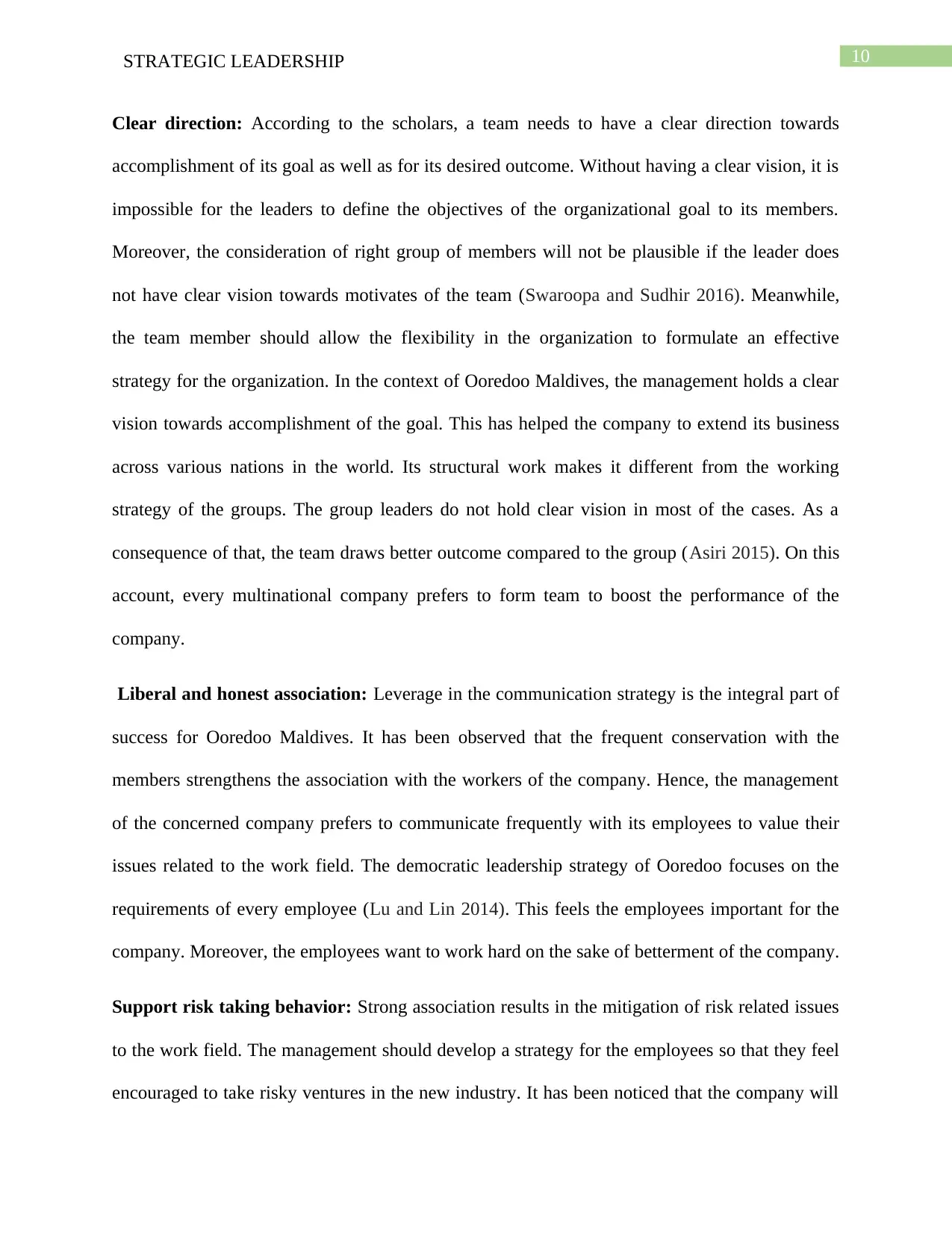
10STRATEGIC LEADERSHIP
Clear direction: According to the scholars, a team needs to have a clear direction towards
accomplishment of its goal as well as for its desired outcome. Without having a clear vision, it is
impossible for the leaders to define the objectives of the organizational goal to its members.
Moreover, the consideration of right group of members will not be plausible if the leader does
not have clear vision towards motivates of the team (Swaroopa and Sudhir 2016). Meanwhile,
the team member should allow the flexibility in the organization to formulate an effective
strategy for the organization. In the context of Ooredoo Maldives, the management holds a clear
vision towards accomplishment of the goal. This has helped the company to extend its business
across various nations in the world. Its structural work makes it different from the working
strategy of the groups. The group leaders do not hold clear vision in most of the cases. As a
consequence of that, the team draws better outcome compared to the group (Asiri 2015). On this
account, every multinational company prefers to form team to boost the performance of the
company.
Liberal and honest association: Leverage in the communication strategy is the integral part of
success for Ooredoo Maldives. It has been observed that the frequent conservation with the
members strengthens the association with the workers of the company. Hence, the management
of the concerned company prefers to communicate frequently with its employees to value their
issues related to the work field. The democratic leadership strategy of Ooredoo focuses on the
requirements of every employee (Lu and Lin 2014). This feels the employees important for the
company. Moreover, the employees want to work hard on the sake of betterment of the company.
Support risk taking behavior: Strong association results in the mitigation of risk related issues
to the work field. The management should develop a strategy for the employees so that they feel
encouraged to take risky ventures in the new industry. It has been noticed that the company will
Clear direction: According to the scholars, a team needs to have a clear direction towards
accomplishment of its goal as well as for its desired outcome. Without having a clear vision, it is
impossible for the leaders to define the objectives of the organizational goal to its members.
Moreover, the consideration of right group of members will not be plausible if the leader does
not have clear vision towards motivates of the team (Swaroopa and Sudhir 2016). Meanwhile,
the team member should allow the flexibility in the organization to formulate an effective
strategy for the organization. In the context of Ooredoo Maldives, the management holds a clear
vision towards accomplishment of the goal. This has helped the company to extend its business
across various nations in the world. Its structural work makes it different from the working
strategy of the groups. The group leaders do not hold clear vision in most of the cases. As a
consequence of that, the team draws better outcome compared to the group (Asiri 2015). On this
account, every multinational company prefers to form team to boost the performance of the
company.
Liberal and honest association: Leverage in the communication strategy is the integral part of
success for Ooredoo Maldives. It has been observed that the frequent conservation with the
members strengthens the association with the workers of the company. Hence, the management
of the concerned company prefers to communicate frequently with its employees to value their
issues related to the work field. The democratic leadership strategy of Ooredoo focuses on the
requirements of every employee (Lu and Lin 2014). This feels the employees important for the
company. Moreover, the employees want to work hard on the sake of betterment of the company.
Support risk taking behavior: Strong association results in the mitigation of risk related issues
to the work field. The management should develop a strategy for the employees so that they feel
encouraged to take risky ventures in the new industry. It has been noticed that the company will
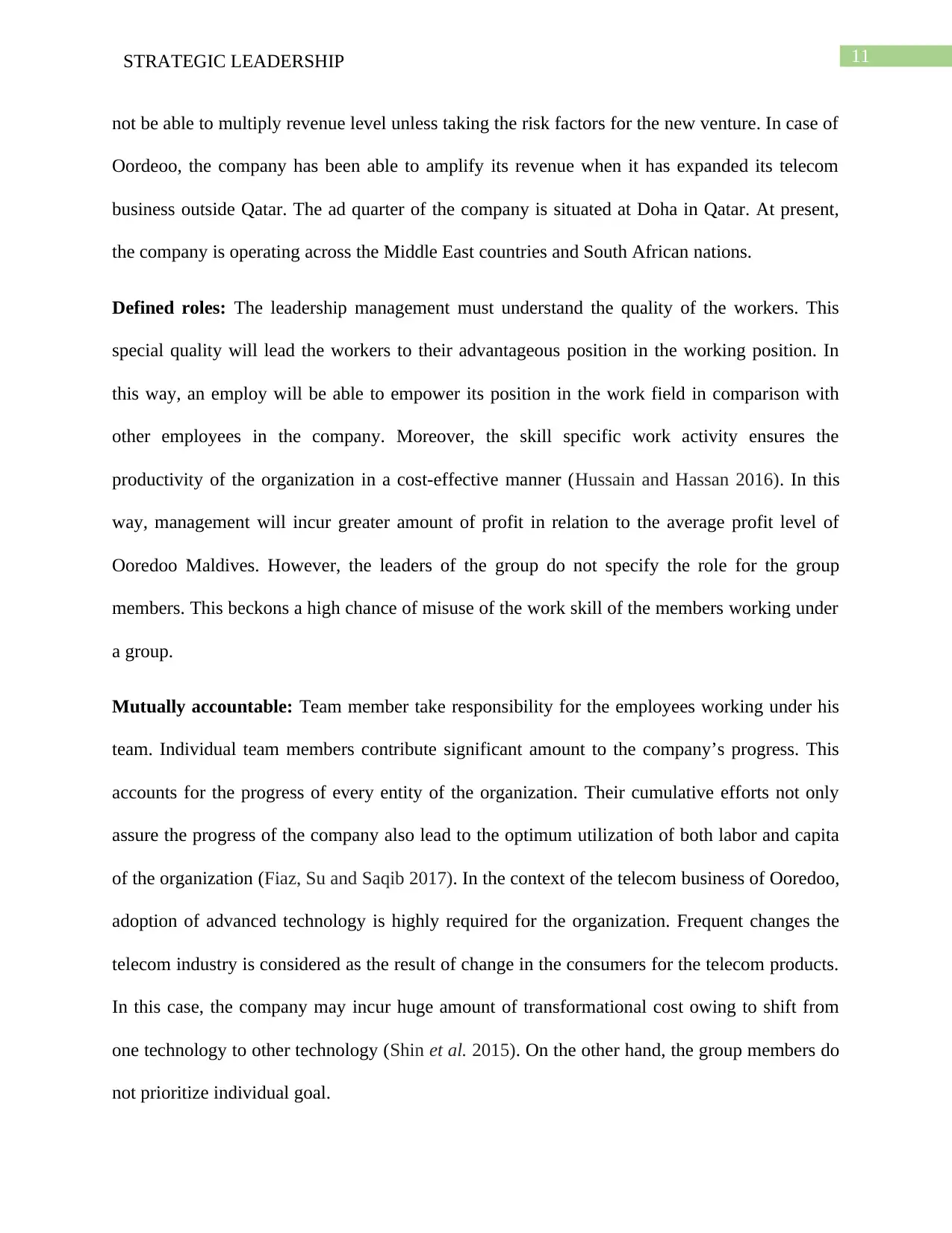
11STRATEGIC LEADERSHIP
not be able to multiply revenue level unless taking the risk factors for the new venture. In case of
Oordeoo, the company has been able to amplify its revenue when it has expanded its telecom
business outside Qatar. The ad quarter of the company is situated at Doha in Qatar. At present,
the company is operating across the Middle East countries and South African nations.
Defined roles: The leadership management must understand the quality of the workers. This
special quality will lead the workers to their advantageous position in the working position. In
this way, an employ will be able to empower its position in the work field in comparison with
other employees in the company. Moreover, the skill specific work activity ensures the
productivity of the organization in a cost-effective manner (Hussain and Hassan 2016). In this
way, management will incur greater amount of profit in relation to the average profit level of
Ooredoo Maldives. However, the leaders of the group do not specify the role for the group
members. This beckons a high chance of misuse of the work skill of the members working under
a group.
Mutually accountable: Team member take responsibility for the employees working under his
team. Individual team members contribute significant amount to the company’s progress. This
accounts for the progress of every entity of the organization. Their cumulative efforts not only
assure the progress of the company also lead to the optimum utilization of both labor and capita
of the organization (Fiaz, Su and Saqib 2017). In the context of the telecom business of Ooredoo,
adoption of advanced technology is highly required for the organization. Frequent changes the
telecom industry is considered as the result of change in the consumers for the telecom products.
In this case, the company may incur huge amount of transformational cost owing to shift from
one technology to other technology (Shin et al. 2015). On the other hand, the group members do
not prioritize individual goal.
not be able to multiply revenue level unless taking the risk factors for the new venture. In case of
Oordeoo, the company has been able to amplify its revenue when it has expanded its telecom
business outside Qatar. The ad quarter of the company is situated at Doha in Qatar. At present,
the company is operating across the Middle East countries and South African nations.
Defined roles: The leadership management must understand the quality of the workers. This
special quality will lead the workers to their advantageous position in the working position. In
this way, an employ will be able to empower its position in the work field in comparison with
other employees in the company. Moreover, the skill specific work activity ensures the
productivity of the organization in a cost-effective manner (Hussain and Hassan 2016). In this
way, management will incur greater amount of profit in relation to the average profit level of
Ooredoo Maldives. However, the leaders of the group do not specify the role for the group
members. This beckons a high chance of misuse of the work skill of the members working under
a group.
Mutually accountable: Team member take responsibility for the employees working under his
team. Individual team members contribute significant amount to the company’s progress. This
accounts for the progress of every entity of the organization. Their cumulative efforts not only
assure the progress of the company also lead to the optimum utilization of both labor and capita
of the organization (Fiaz, Su and Saqib 2017). In the context of the telecom business of Ooredoo,
adoption of advanced technology is highly required for the organization. Frequent changes the
telecom industry is considered as the result of change in the consumers for the telecom products.
In this case, the company may incur huge amount of transformational cost owing to shift from
one technology to other technology (Shin et al. 2015). On the other hand, the group members do
not prioritize individual goal.
⊘ This is a preview!⊘
Do you want full access?
Subscribe today to unlock all pages.

Trusted by 1+ million students worldwide
1 out of 24
Related Documents
Your All-in-One AI-Powered Toolkit for Academic Success.
+13062052269
info@desklib.com
Available 24*7 on WhatsApp / Email
![[object Object]](/_next/static/media/star-bottom.7253800d.svg)
Unlock your academic potential
Copyright © 2020–2025 A2Z Services. All Rights Reserved. Developed and managed by ZUCOL.





